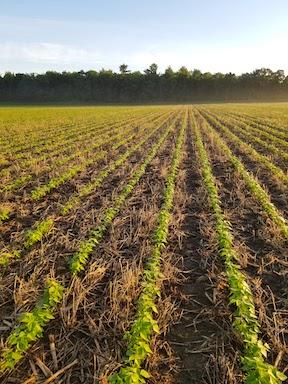
John Ruzicka has made no-tilling vegetable crops a win-win. His crops are cleaner at harvest, and he has eliminated wind and water erosion. Like other farmers in his area who produce for canning companies, Ruzicka used to make multiple tillage passes before planting. A dust storm about 10 years ago made him question the practice.
“The dust storm was tearing up young corn plants,” says Ruzicka. “I was setting up a center pivot to make a pass just to reduce dust, and I thought there had to be a better way.”
Ruzicka started exploring no-till by planting sweet corn into terminated rye. When that worked, he decided to try planting green beans into terminated rye as well.
“I tried a few acres, and it worked well,” says Ruzicka. “I was concerned the harvester would pull in corn stubble, but it worked better on the no-tilled ground than it had on dirt.”
For the past 4 years, he has also no-till planted canning peas. Doing so required Ruzicka to invest in a Great Plains no-till drill.
“The contractor who buys our peas custom plants the other farms with a big air seeder and field cultivator,” explains Ruzicka. “Tillage is a given with it, so we plant our own.”
Shifting to no-till has improved planting efficiency as well as harvest. Along with cover crops, no-till planting has enhanced water infiltration. Previously a 1/2-in. rain would turn fields into a mudpie.
“Now when we get rain, it soaks in,” says Ruzicka. “We don’t have ponding because the water doesn’t run off to the lowest area.”
Like other no-tillers, Ruzicka cites increased earthworms in his fields. He also notes reduced disease pressure.
“I feel like we are seeing less white mold in green beans and less root rot in the peas, thanks to the cover crops,” says Ruzicka.
One of his biggest challenges is timing cover crop termination. This is a bigger concern for canning crops, due to scheduled planting for a crop like sweet corn that can extend from mid-May to mid-June.
“I have to manage termination, so it doesn’t compete with the crop I am planting,” says Ruzicka. “I also have to do more scouting for insect pests like armyworms.”
He advises going slow when making the transition from full tillage to no-till. He suggests trying a few acres and talking with other no-tillers about what they’ve learned.
“No-tillers love to talk about it, and they love to answer questions,” says Ruzicka.
Ruzicka admits that some of his neighbors laugh at what he has done, while others ask questions and then try a little on their own. He doesn’t care what others think, but he does hope others will try it on limited acres.
“It’s taken time, but now it’s working,” says Ruzicka. “If you try it and struggle, don’t give up. It takes a systems approach. One year doesn’t change the whole program. It takes a few years before a field is really no-till.”
Contact: FARM SHOW Followup, Guth Farm, 7212 County Rd. BB, Bancroft, Wis. 54921 (ph 715-366-4946 or 715-498-0892; john.ruzicka@guthfarm.com).
